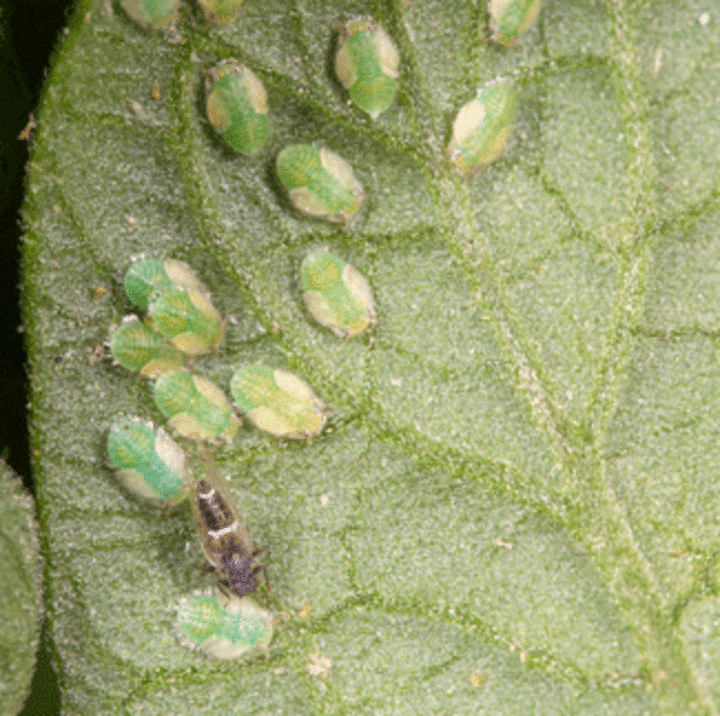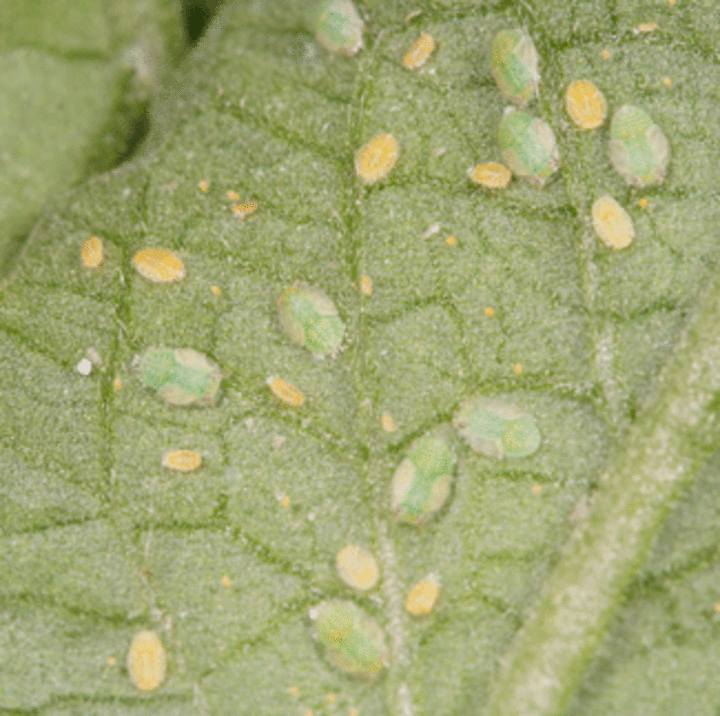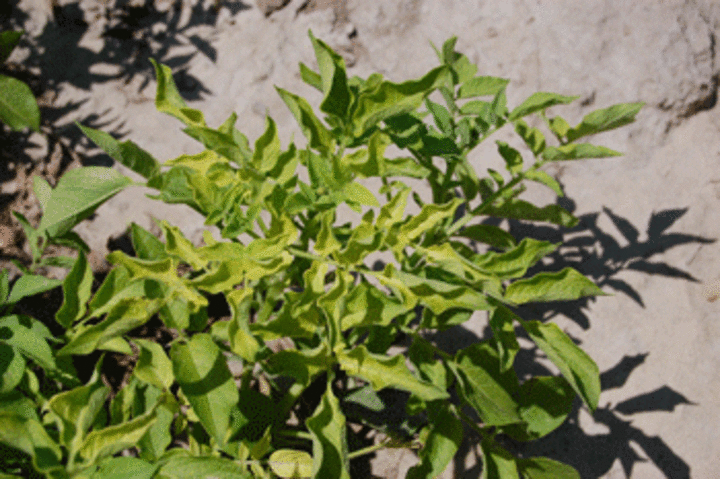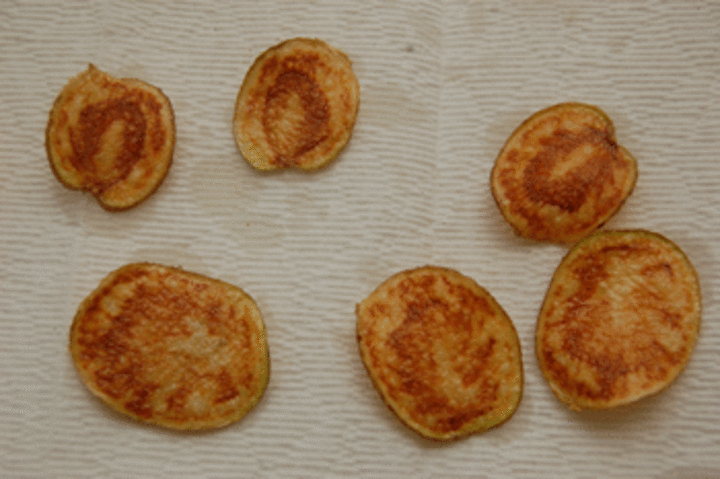
|

|
| Figure 1. Potato psyllid adult and large nymphs. Winged adult on lower left, large nymphs adjacent to adult. | Figure 2. Large and small potato psyllid nymphs and eggs (small, orange and somewhat football-shaped). |
June 13, 2011
This content requires Flash Download the free Flash Player now!
//
Get The Code to Embed This Audio Clip
Last year we received numerous reports of infestations of potato psyllids in potato across the region. Currently, the potato crop in western Nebraska is in Growth Stage II (developing leaves and branches aboveground, roots and stolons developing below ground). Considering that the spring weather pattern has been much the same this spring as last (at least in the Nebraska Panhandle), it would be a good idea to begin monitoring for this insect.
Biology, Ecology, and Disease
|

Figure 3. Psyllid-yellows like symptoms of potato. Note that some nutrient deficiencies can cause similar discoloration.

Figure 4. A sliced potato that is infected with ‘Ca. Liberibacter solanacearum’ showing zebra chip symptoms.

Figure 5. Fried chips showing the characteristic discoloration of chips infected with zebra chip disease. |
The potato psyllid, Bactericera cockerelli, is a very small insect (Figures 1 and 2) that predominately causes damage on eggplant, pepper, tomato, and potato. It also can survive on solanaceous weeds, such as matrimony vine. It is flattened and scale-like as a nymph and primarily feeds on the underside of leaves. Because of the insect’s small size and cryptic and secluded nature, it often is not noticed until populations become large or symptoms develop.
In potato, direct injury causes a disease known as psyllid yellows (Figure 3). When a psyllid injects toxic saliva into a plant, the leaves turn yellow and cup or curl upward. If the psyllids attack potatoes early (before tuber set), multiple tubers can develop on each stolon. If the attack occurs late (after tubers are partially developed), the disease can cause retarded growth, misshapen potatoes, and occasionally prematurely sprouting potatoes prior to harvest. Typically, infestation of potatoes prior to tuber set will have the greatest economic impact.
Another disease transmitted by the potato psyllid is zebra chip, so named because of the patterned, brown char that occurs on chips fried from infected tubers (Figures 4 and 5). This disease results from a bacterial pathogen, ‘Ca. Liberibacter solanacearum.’ (The odd nomenclature is because the pathogen is not yet an officially confirmed causative agent.) This disease and its control may require a different management plan than that used to control psyllid yellows and will be discussed in a later article.
Psyllids are most common to the Great Plains and Southwest and may overwinter in southern Arizona, California, New Mexico, Texas, and Utah. In Nebraska, it is important to monitor for the arrival of potato psyllids and to assess their abundance. It is especially important to note that the conditions that favor their overwintering in the southern U.S. and their migration northward do not occur every year.
Management
It is critical that you scout for potato psyllids before initiating any psyllid management program because economically important populations can be sporadic from year to year. For scouting, concentrate on the lower leaves of early potato plantings or scout for psyllids on solanaceous weeds that may be growing near potato fields. Yellow sticky cards or pan traps also can be used to monitor for potato psyllids; however, there is no reliable correlation between trap catch numbers and potato damage. This is partly because the traps capture the winged adults and not the nymphs. It is the nymphs that are correlated to damage and their development will depend on local environmental conditions. However, trap data do indicate the presence or absence of psyllids and can provide information regarding the movement of the psyllids if traps are monitored over a regional scale.
To scout for potato psyllid nymphs (i.e., the stage associated with psyllid yellows), randomly select five groups of 10 lower leaflets throughout the field (50 leaflets total). Consider treating the field if there is more than one nymph per 10 leaflets on pre-bloom plants or three to four nymphs on plants in full bloom or older. It is important to take samples that are representative of the entire field. Be aware of features in the landscape that may facilitate the adults’ settling from the air. For example, a tree line can create eddies that could concentrate psyllid numbers in adjacent fields. Also, psyllids may invade fields from borders with weeds such as ground cherry or nightshade.
Although numerous natural enemies attack potato psyllids and suppress their abundance, chemical application may be needed if psyllid abundance reaches the threshold. If chemicals are applied, it is important to have good canopy penetration and thorough coverage of the foliage (Table 1).
Take care to not be overly reliant on any one chemical mode of action as chemical resistance has been well documented for potato insects such as aphids and the Colorado potato beetle.
Jeff Bradshaw, Extension Entomology Specialist
Bob Harveson, Extension Plant Pathology Specialist
Both at the Panhandle REC, Scottsbluff
|
Table 1. Insecticides labeled for potato psyllid control in potato* |
||||
|
Mode of Action |
Product Name |
Common Name |
Rate (maximum ai per season) |
Restrictions/Comments |
| 6 | Agri-Mek 0.15 EC | Abamectin | 8.0 - 16.0 oz/ac (0.019 lbs/ac per application) |
Restricted Use Pesticide. Do not make more than 2 sequential applications of any abamectin product. Do not apply within 14 days of harvest. REI 12 hours. |
| UN | Aza-Direct | Azadirachtin | 1-2 pints/ac |
No preharvest restriction. REI 4 hours. |
| 3 | Baythroid XL | Beta-cyfluthrin | 1.6 - 2.8 oz/ac (0.132 lbs/ac) |
Restricted Use Pesticide. No preharvest restriction. REI 12 hours. |
| 3 | Athena | Bifenthrin | 10.0 - 17.0 oz/ac (0.5 lbs/ac of bifenthriin) |
Restricted Use Pesticide. Do not apply within 21 days of harvest. REI 12 hours |
| 3/4A | Brigadier | Bifenthrin/Imidacloprid |
At-plant application: 16.0 - 25.6 oz/ac (0.2 lbs/ac of imidacloprid and 0.3 lbs/ac bifenthrin) |
Restricted Use Pesticide. Do not apply within 21 days of harvest. REI 12 hours. |
| 4A | Belay | Clothianidin | 9.0 - 12.0 oz/ac in-furrow (0.2 lbs/ac) |
Only provides suppression of potato psyllids. REI 12 hours. |
| 3 | Renounce 20WP | Cyfluthrin | 1.0 - 2.0 oz/ac (0.263 lbs/ac) |
Restricted Use Pesticide. No preharvest restriction. REI 12 hours. |
| 4A | Scorpion 35SL | Dinotefuran |
Soil application: 11.0 - 13.0 oz/ac (0.33 lb/ac) Foliar application: 2.0 - 2.75 oz/ac (0.196 lb/ac) |
Do not apply within 7 days of harvest. REI 12 hours |
| 3 | Adjourn | Esfenvalerate | 2.9 - 5.8 oz/ac (0.35 lb/ac) | Restricted Use Pesticide. Do not apply within 7 days of harvest. REI 12 hours |
| 3 | Asana XL | Esfenvalerate | 2.9 - 5.8 oz/ac (0.35 lb/ac) | Restricted Use Pesticide. Do not apply within 7 days of harvest. REI 12 hours |
| 4A | Admire Pro | Imidacloprid | 5.7 - 8.7 oz/ac (0.31 lb/ac) | Soil application or on seed pieces. REI 12 hours. |
| 4A | Advise 2FL | Imidacloprid |
Soil application: 0.9 - 1.3 oz/1,000 row ft or 13.0 - 20 oz/ac (0.31 lb/ac) Foliar application: 3.0 oz/ac (0.19 lb/ac) Seed treatment: 0.8 oz/ 100 lbs seed (0.31 lb/ac) |
Foliar application: Do not apply within 7 days of harvest. Do not reapply within 7 days of previous treatment. Seed treatment: Do not use seed pieces for food, feed, or fodder. Do not apply any other in-furrow imadacloprid product following seed treatment with Advise 2FL. |
| 3 | Warrior II with Zeon Technology | Lambda-cyhalothrin | 1.28 - 1.92 oz/ac (0.12 lb/ac) | Restricted Use Pesticide. This is a Restricted Use Pesticide. Do not apply within 7 days of harvest. REI 24 hours |
| 3 | Ambush 25W | Permethrin | 3.2 - 12.8 oz/ac (1.6 lb/ac) | Restricted Use Pesticide. Do not apply within 14 days of harvest. REI 12 hours. |
| 1b | Phorate 20G | Phorate |
Light or sandy soil: 11.3 oz/1,000 row ft Heavy or clay soil: 17.3 oz/1,000 row ft (0.125 lb/ac) |
Restricted Use Pesticide. Do not apply within 90 days of harvest. REI 48 hours. |
| 23 | Oberon 2 SC | Spiromesifen | 4.0 - 8.0 oz/ac (0.5 lbs/ac) | Do not apply within 7 days of harvest. REI 12 hours |
| 4A | CruiserMaxx Potato | Thiamethoxam |
Seed rate
Seed rate 2200 - 2500 lb/ac: 0.19 - 0.23 oz/ac Seed rate 2600 - 3000 lb/ac: 0.19 oz/ac (0.125 lb/ac) |
REI 12 hours. |
| *This list is not conclusive for psyllid control in potato. See http://www.greenbook.net, http://www.cdms.net/, or other resources for additional registrations. This information is presented in abbreviated form. Be sure to consult the label for additional information. This list does not constitute an endorsement of any product. | ||||
